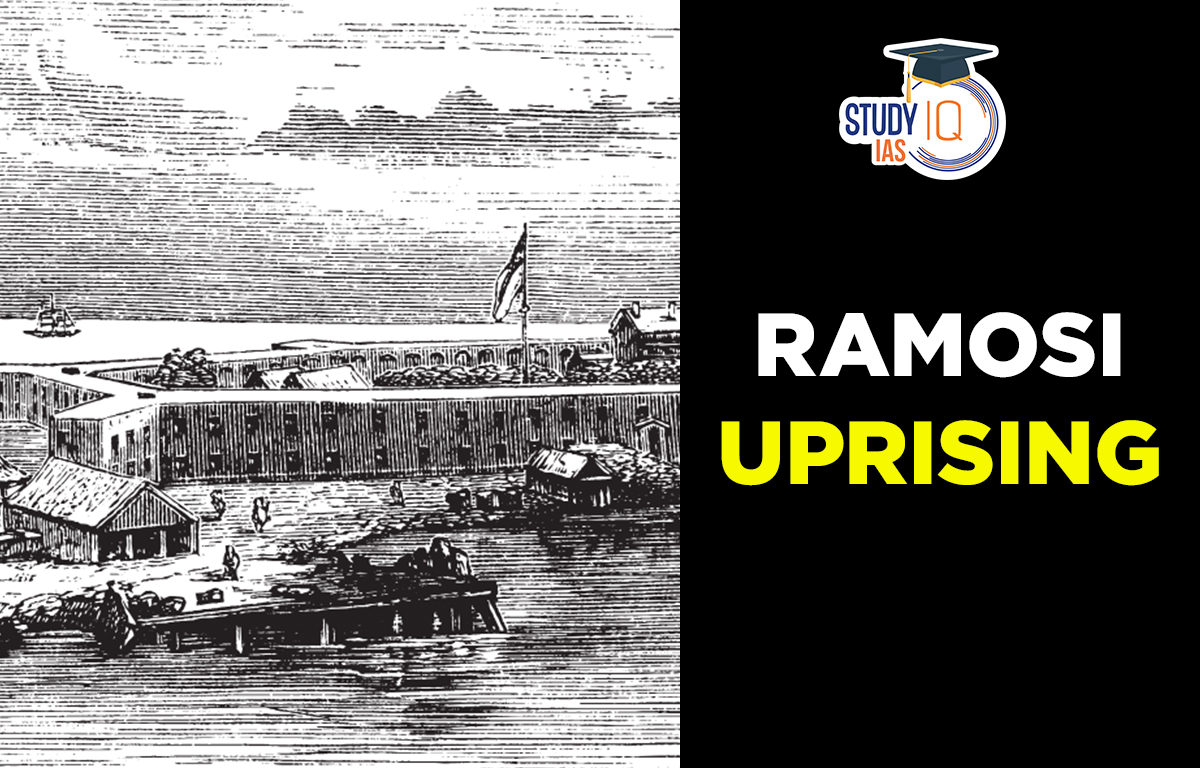Table of Contents
Ramosi Uprising
The Maharashtra-based Ramosi Uprising (1877–1887) was a farmer uprising against the British government’s lack of anti–famine action. Vasudev Balwant Phadke was in charge of it. Instead of calm protests, there were violent ones. In Satara, the Ramosi revolt against British authority took place in 1822 under the leadership of Chittur Singh.
The British annexation strategy infuriated the Ramosis. Ramosis’ widespread unemployment as a result of the British annexation of Maratha territories in 1818 was the primary driver of the rebellion. However, the British eventually subsumed the organisation to quell it. For UPSC exam preparation, this document contains all the necessary information about the Ramosi Uprising.
Read More: Bhil Revolt
Ramosi Uprising History
The hill clans of the Western Ghats make up the Ramosis. The Ramosis, who had worked for the Maratha government, lost their source of income after the British annexation of the Maratha lands. Ramosis objected to the annexation strategy. They had rejected British rule and the British form of government. In 1822, they arose under Chittur Singh and pillaged the region around Satara.
The hill tribes of the Western Ghats known as Ramosis had not accepted British authority. They worked in the lower levels of the Maratha army and police prior to the collapse of the Maratha Empire. Ramosis who had previously worked for the Maratha government lost their source of income after the British seized the Maratha territories in 1818. In the middle of the famine, the Brits imposed taxes on these unemployed families. These tribal people felt that the new British government structure was extremely unfair to them, which sparked the infamous Ramosi revolt.
Read More: Khond Uprisings
Ramosi Uprising and Timeline
Ramosi Rebellion 1822-1829
Under the leadership of Chittur Singh, the Ramosis revolted against the British in 1822 and pillaged the region close to Satara. Later, from 1825 to 1829, the tribal groups in the area coordinated a number of revolutionary events as part of the second phase of the uprising.
The Ramosis again rebelled against the British in 1825–1826, this time under the guidance of Umaji Naik of Poona and Bapu Trimbakji Sawant, one of his supporters. They revolt because of Pune’s severe scarcity and famine. They demolished the Deccan for three years. The unrest persisted until 1829. In order to put an end to the uprising, the British adopted a pacifist approach towards the Ramosis and even hired some of them as hill cops.
Read More: Santhal Rebellion
Ramosi Rebellion of 1879
The 1879 Ramosi Revolt was a peasant rebellion against the British government’s lack of anti-famine action. It was the first of Maharashtra’s revolutionary actions. Vasudev Balwant Phadke served as the leader of the uprising in the Satara area of Maharashtra. Peasants endured even more difficulties as a result of the Deccan famine in 1776–1777. The British government’s extortionate land tax policies infuriated the peasants. Vasudev Balwant Phadke toured the Deccan area urging people to work towards a free Indian republic as a result of a severe famine and the British administration’s indifference.
Phadke assembled a group of members of the Ramosi caste after being unable to obtain backing from the educated classes. Phadke self-taught himself how to horse, shoot, and fence. He then established the Ramosi Peasant Force with the intention of driving out the British by inciting a military uprising and sabotaging communication channels.
Read More: Munda Rebellion
Ramosi Uprising Result
Lacking money, Phadke wanted to create their own army. To gather money, they made the decision to rob government treasuries. They began by conducting a treasury raid in the Pune district’s Shirur taluka’s Dhamari hamlet. The income tax was stored in the home of a local businessman named Balchand Fojmal Sankla and was collected to be sent to the British government. They broke into the home and stole the cash to aid the villager’s suffering from famine.
Such attacks were frequently carried out by Phadke in areas close to Pune’s Shirur and Khed talukas. The overall plan would be to disable all of the British troops’ communications before conducting a treasury raid. These attacks served to resupply starving peasant communities.
Meanwhile, Daulatrav Naik, the head of Ramosi and a well-known ally of Phadke, moved in the direction of the Konkan region on the western shore. They carried out raids on Palaspe and Chilkhali in May 1879, taking about 1.5 lakh rupees in plunder. The British troops ambushed Naik on his way back to Ghat Matha, where they fatally shot him. His passing caused Phadke’s uprising to falter.
Read More: Kuka Movement
Ramosi Uprising UPSC
On July 20, 1879, while Phadke was en route to Pandharpur, the British troops engaged him in a fierce battle in the Kaladgi district before taking him prisoner inside a temple. He was then brought to Pune for a trial before being taken to the Aden prison. He broke out of jail on February 13th, 1883, but was quickly apprehended. He then began a starvation strike and passed away on February 17, 1883. Read Ramosi Uprising in detail in this article for UPSC Exam Preparation.
Read More: Chuar Uprising


 Birsa Munda Birth Anniversary 2025: Life...
Birsa Munda Birth Anniversary 2025: Life...
 Military Innovations of Afghans and Turk...
Military Innovations of Afghans and Turk...
 Self-Respect Movement, History, Objectiv...
Self-Respect Movement, History, Objectiv...

























